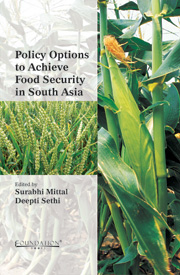Book contents
- Frontmatter
- Contents
- List of Contributors
- Foreword
- Acknowledgements
- List of Abbreviations
- 1 Food Security in South Asia
- 2 Food Security in India: Policies and Options
- 3 Multiple Facets of Food (In) Security in Sri Lanka: An Input to Food Policy
- 4 Food Security in Bangladesh: Achievements, Challenges and Way Forward
- 5 State of Agriculture and Food Security in Pakistan
- 6 Food Security Situation in Nepal: Issues and Suggested Policy Measures
- 7 Food Security in Maldives
- 8 Role of Regional Trade and Rural Development for Food Security in Bhutan
- 9 Food Security in Afghanistan
6 - Food Security Situation in Nepal: Issues and Suggested Policy Measures
Published online by Cambridge University Press: 05 June 2012
- Frontmatter
- Contents
- List of Contributors
- Foreword
- Acknowledgements
- List of Abbreviations
- 1 Food Security in South Asia
- 2 Food Security in India: Policies and Options
- 3 Multiple Facets of Food (In) Security in Sri Lanka: An Input to Food Policy
- 4 Food Security in Bangladesh: Achievements, Challenges and Way Forward
- 5 State of Agriculture and Food Security in Pakistan
- 6 Food Security Situation in Nepal: Issues and Suggested Policy Measures
- 7 Food Security in Maldives
- 8 Role of Regional Trade and Rural Development for Food Security in Bhutan
- 9 Food Security in Afghanistan
Summary
Introduction
Agriculture is the single largest sector in Nepal, accounting for 34 per cent of GDP at present, although its share in total GDP has declined over the years. The growth of the Nepalese economy is determined by the agricultural growth. Almost 80 per cent of the population of Nepal reside in rural areas and pursues agricultural activities (National Planning Commission and MOPE, 2003). Only about 17 per cent of Nepal's total land area is suitable for agriculture; 2.5 million hectares with a cropping intensity varying from one to three crops per year. Customarily, the country is classified into three ecological divisions – mountain, hills and terai. The average growth rate of agriculture GDP during period 2001–2006 was 2.8 per cent, which fluctuates highly from year to year, mainly because of adverse weather conditions.
The cereal crops, mainly paddy, maize, millet, wheat, and barley, cover 80 per cent of the total cultivated area in the country. Paddy is the most important crop contributing to half of total cereal production and 16 per cent of the total cultivated area. Maize is the second most important cereal, contributing 25 per cent of the total cereal production. Wheat being the third most important cereal, contributed 20 per cent of total cereal production in 2006–07. Pulses are an important source of protein in the Nepalese diet of which lentils account for 60 per cent of the pulse production.
- Type
- Chapter
- Information
- Policy Options to Achieve Food Security in South Asia , pp. 137 - 160Publisher: Foundation BooksPrint publication year: 2011



